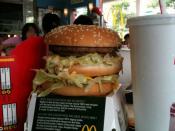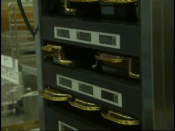McDonalds case Part B
I. Introduction
McDonalds is a very famous fast-food restaurant with more than 31,000 worldwide branches. Its main dishes are hamburger and fries. McDonalds has limited choice of food but in turn it serves its patrons fast. However, the restaurant is about 41 years olds now and consequently it becomes penetrated and mature, it has more competitions and tough challenges.
In Operation management term, McDonalds has highly qualified operating system, its kitchen and its management, to serve high volume customers. As years goes by, the demands change. People become more mobile and have dynamically changed their schedules to eat from at dawn to midnight and also become more selective. They don't want static menus anymore. They want broader choice of sandwiches or burgers at their lunch or dinner time, and, the most crucial thing, they still expect fast service as before or even faster. To handle this challenge, McDonalds has upgraded its kitchen system into Just-In-Time kitchen System named Made-For-You.
The Goals of this new system are:
Improved food quality, including health concern and food safety requirements
More flexible and compatible with new menus
Built better and faster customer service
Used human resources ,e.g. crews/employees, more effective and productive
II. Made-For-You System versus Old Process System
II.a. Technology and Process Differences
The Process
In the old way, McDonald's was used to applying Make-to-Stock for preparing its food to customers (Look at Exhibit 1)
In this process, finished products were kept in the metal warming bin (storage) until a customer order the product(s). How many products are going to be kept is its manager's prediction/forecast. In early years, demands were not so complicated, just around Big Mac and/or fried fries.
Since early 2000, McDonald's uses Make-to-Order system to meet with changing demands which need more variety, yet still...


